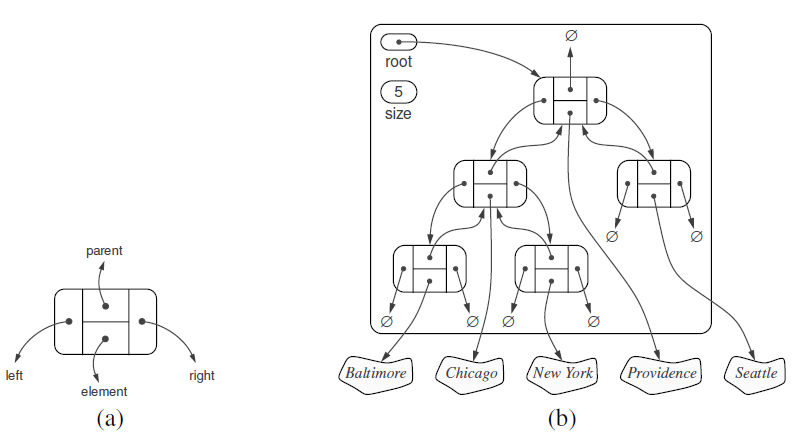1、树简介
树是一种非线性结构。比数组和链表快。
树不是顺序排列的对象之间简单的前后关系,而是分层的,有些对象在上面,有些对象在下面。
树是一种抽象的数据类型,它分层次地存储元素。除了顶部元素外,树中的每个元素都有一个父元素和零个或多个子元素。
一棵树通常是通过在椭圆或矩形中放置元素,并通过直线画出父母和孩子之间的连接来实现的。
通常称顶部元素为树的根,但它被绘制为最高的元素,其他元素被连接在下面(与植物树相反)。
设p是t树的一个节点的位置,p的深度是p的祖先的个数,不包括p本身。
p的深度也可以递归定义为:
- 如果p是根,则p的深度为0。
- 否则,p的深度等于1加上p的父结点的深度。
树T中位置p的高度也是递归定义的:
- 如果p是叶节点,那么p的高度是0。
- 否则,p的高度比p子结点的最大高度大1。
代码如下:
class Tree:"""abstract base class representing a tree structure"""# ----------------------nested Position class----------------class Position:"""an abstraction reprenting the location of a single element"""def element(self):"""return the element stored at this Position"""raise NotImplementedError('must be implemented by subclass')def __eq__(self, other):"""return true if other Position represents the same location"""raise NotImplementedError('must be implemented by subclass')def __ne__(self, other):return not (self == other)# --------------abstract methods that concrete subclass must support------def root(self):"""return position representing the tree's root (None if empty)"""raise NotImplementedError('must be implemented by subclass')def parent(self, p):"""Return Position representing p s parent (or None if p is root)"""raise NotImplementedError('must be implemented by subclass')def num_children(self, p):"""Return the number of children that Position p has"""raise NotImplementedError('must be implemented by subclass')def children(self, p):"""Generate an iteration of Positions representing p s children"""raise NotImplementedError('must be implemented by subclass')def __len__(self):"""Return the total number of elements in the tree"""raise NotImplementedError('must be implemented by subclass')# ---------- concrete methods implemented in this class ----------def is_root(self, p):return self.root() == pdef is_leaf(self, p):return self.num_children(p) == 0def is_empty(self):return len(self) == 0def depth(self, p):"""Return the number of levels separating Position p from the root."""if self.is_root(p):return 0else:return self.depth(self.parent(p)) + 1def _height1(self):"""return the height of the tree"""return max(self.depth(p) for p in self.positions() if self.is_leaf(p))def _height2(self, p):"""return the height of the subtree rooted at position p"""if self.is_leaf(p):return 0else:return max(self._height2(c) for c in self.children(p)) + 1def height(self, p=None):"""return the height of the subtree rooted at postion p.if p is None, return the height of the entire tree"""if p is None:p = self.root()return self._height2(p)
2、二叉树
二叉树是一种有序树,具有以下属性:
- 每个节点最多有两个子节点。
- 每个子节点都被标记为左子节点或右子节点。
- 节点顺序,左子节点在右子节点之前
代码如下:
class BinaryTree(Tree):"""abstract base class representing a binary tree structure"""# --------------additional abstract methods------------def left(self, p):"""return a position representing p's left child. """raise NotImplementedError('must be implemented by subclass')def right(self, p):"""return a position representing p's right child"""raise NotImplementedError('must be implemented by subclass')# -------concrete methods implemented in this class--------def sibling(self, p):"""return a position representing p's sibling """parent = self.parent(p)if parent is None:return Noneelse:if p == self.left(parent):return self.right(parent)else:return self.left(parent)def children(self, p):"""generate an iteration of positions representing p's children"""if self.left(p) is not None:yield self.left(p)if self.right(p) is not None:yield self.right(p)
3、链表树

代码如下:
LinkedQueue
import LinkedQueue
class LinkedBinaryTree(BinaryTree):
"""Linked representation of a binary tree structure"""
class _Node:
"""lightweight , nonpublic class for storing a node"""
__slots__ = '_element', '_parent', '_left', '_right'
def __init__(self, element, parent=None, left=None, right=None):
self._element = element
self._parent = parent
self._left = left
self._right = right
class Position(BinaryTree.Position):
"""an abstraction representing the location of a single element"""
def __init__(self, container, node):
"""constructor should not be invoked by user"""
self._container = container
self._node = node
def element(self):
"""return the element stored at this position"""
return self._node._element
def __eq__(self, other):
"""return true if other is a position representing the same location"""
return type(other) is type(self) and other._node is self._node
def _validate(self, p):
"""return associated node, if position is valid"""
if not isinstance(p, self.Position):
raise TypeError('p must be proper position type')
if p._container is not self:
raise ValueError('p does not belong to this container')
if p._node._parent is p._node: # convention for deprecated nodes
raise ValueError('p is no longer valid')
return p._node
def _make_position(self, node):
"""return position instance for given node """
return self.Position(self, node) if node is not None else None
# -------------------------- binary tree constructor --------------------------
def __init__(self):
"""create an initially empty binary tree"""
self._root = None
self._size = 0
# -------------------------- public accessors --------------------------
def __len__(self):
return self._size
def root(self):
return self._make_position(self._root)
def parent(self, p):
"""return the position of p's parent"""
node = self._validate(p)
return self._make_position(node._parent)
def left(self, p):
node = self._validate(p)
return self._make_position(node._left)
def right(self, p):
node = self._validate(p)
return self._make_position(node._right)
def num_children(self, p):
node = self._validate(p)
count = 0
if node._left is not None:
count += 1
if node._right is not None:
count += 1
return count
def _add_root(self, e):
"""place element e at the root of an empty tree and return new position"""
if self._root is not None: raise ValueError('root exists')
self._size = 1
self._root = self._Node(e)
return self._make_position(self._root)
def _add_left(self, p, e):
"""
create a new left child for position p,storing element e.
return ValueError if Position p is invalid or p already has a left child
"""
node = self._validate(p)
if node._left is not None: raise ValueError('left child exists')
node._left = self._Node(e, node) # node is its parent
return self._make_position(node._left)
def _add_right(self, p, e):
node = self._validate(p)
if node._right is not None: raise ValueError('right child exists')
node._right = self._Node(e, node)
return self._make_position(node._right)
def _replace(self, p, e):
"""Replace the element at position p with e, and return old element"""
node = self._validate(p)
old = node._element
node._element = e
return old
def _delete(self, p):
"""
delete the node at position p , and replace it with its child , if any.
return the element that had been stored at position p.
raise valueerror if position p is invalid or p has two children
"""
node = self._validate(p)
if self.num_children(p) == 2: raise ValueError('p has two children')
child = node._left if node._left else node._right # might be None
if child is not None:
child._parent = node._parent # child s grandparent becomes parent
if node is self._root:
self.root = child # child becomes root
else:
parent = node._parent
if node is parent._left:
parent._left = child
else:
parent._right = child
self._size -= 1
node._parent = node # convention for deprecated node
return node._element
def _attach(self, p, t1, t2):
"""attach tree t1 and t2 as left and right subtrees of external p"""
node = self._validate(p)
if not self.is_leaf(p): raise ValueError('position must be leaf')
if not type(self) is type(t1) is type(t2): # all 3 trees must be same type
raise TypeError('tree types must match')
self._size += len(t1) + len(t2)
if not t1.is_empty():
t1._root._parent = node # attached t1 as left subtree of node
node._left = t1._root
t1._root = None # set t1 instance to empty
t1._size = 0
if not t2.is_empty(): # attached t2 as right subtree of node
t2._root.parent = node
node._right = t2
t2._root = None
t2._size = 0
def __iter__(self):
"""generate an iteration of the tree's elements"""
for p in self.positions():
yield p.element()
def preorder(self):
"""generate a preorder iteration of positions in the tree"""
if not self.is_empty():
for p in self._subtree_preorder(self.root()):
yield p
def _subtree_preorder(self, p):
"""generate a preorder iteration of positions in subtree rooted at p"""
yield p
for c in self.children(p):
for other in self._subtree_preorder(c):
yield other
def positions(self):
"""generate an iteration of the tree's positions"""
return self.preorder() # return entire preorder iteration
def postorder(self):
"""generate a postorder iteration of positions in the tree"""
if not self.is_empty():
for p in self._subtree_postorder(self.root()):
yield p
def _subtree_postorder(self, p):
"""generate a postorder iteration of positions in subtree rooted at p"""
for c in self.children(p):
for other in self._subtree_postorder(c):
yield other
yield p
def breadthfirst(self):
"""generate a breath-first iteration of the positions of the tree"""
if not self.is_empty():
fringe = LinkedQueue() # known positions not yet yielded
fringe.enqueue(self.root()) # starting with the root
while not fringe.is_empty():
p = fringe.dequeue() # remove from front of the queue
yield p # report this position
for c in self.children(p):
fringe.enqueue(c) # add children to back of queue
def inorder(self):
"""generate a breath-first iteration of the positions"""
if not self.is_empty():
for p in self._subtree_inorder(self.root()):
yield p
def _subtree_inorder(self, p):
"""generate an inorder iteration of positions in subtree rooted at p"""
if self.left(p) is not None: # if left child exists, traverse its subtree
for other in self._subtree_inorder(self.left(p)):
yield other
yield p # visit p between its subtrees
if self.right(p) is not None: # if right child exists, traverse its subtree
for other in self._subtree_inorder(self.right(p)):
yield other
if __name__ == '__main__':
T = LinkedBinaryTree()
T.root()
T.is_empty()
T._add_root(10)
root = T.root()
T._add_left(root, 8)
T._add_right(root, 30)
left = T.left(root)
right = T.right(root)
print('sibling of left: ', T.sibling(left).element())
print('***preorder***')
for p in T.preorder():
print(p.element())
print('***postorder***')
for p in T.postorder():
print(p.element())
print('***inorder***')
for p in T.inorder():
print(p.element())
print('***breadthfirst***')
for p in T.breadthfirst():
print(p.element())

